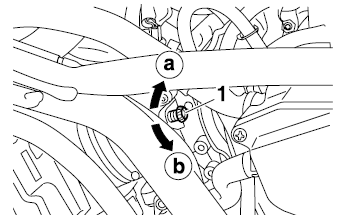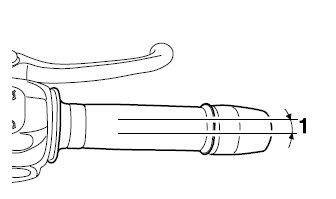 Yamaha MT-03 - Owner's Manual > Adjusting the engine idling speed
Yamaha MT-03 - Owner's Manual > Adjusting the engine idling speed

- Idle adjusting screw
The engine idling speed must be checked and, if necessary, adjusted as follows at the intervals specified in the periodic maintenance and lubrication chart.
The engine should be warm before making this adjustment.
NOTE: The engine is warm when it quickly responds to the throttle.
Check the engine idling speed and, if necessary, adjust it to specification by turning the idle adjusting screw. To increase the engine idling speed, turn the screw in direction (a). To decrease the engine idling speed, turn the screw in direction (b).
Engine idling speed:
1300-1500 r/min
1400-1600 r/min (EU3 version)
NOTE: If the specified idling speed cannot be obtained as described above, have a Yamaha dealer make the adjustment.
Checking the throttle cable free play

- Throttle cable free play
The throttle cable free play should measure 3.0-5.0 mm (0.12-0.20 in) at the throttle grip. Periodically check the throttle cable free play and, if necessary, have a Yamaha dealer adjust it.
Valve clearance
The valve clearance changes with use, resulting in improper air-fuel mixture and/or engine noise. To prevent this from occurring, the valve clearance must be adjusted by a Yamaha dealer at the intervals specified in the periodic maintenance and lubrication chart.
Tires
To maximize the performance, durability, and safe operation of your motorcycle, note the following points regarding the specified tires.
Tire air pressure
The tire air pressure should be checked and, if necessary, adjusted before each ride.
WARNING
- The tire air pressure must be checked and adjusted on cold tires (i.e., when the temperature of the tires equals the ambient temperature).
- The tire air pressure must be adjusted in accordance with the riding speed and with the total weight of rider, passenger, cargo, and accessories approved for this model.
Tire air pressure (measured on cold tires):
Up to 90 kg (198 lb):
Front: 210 kPa (30 psi) (2.1 kgf/cm2)
Rear: 230 kPa (33 psi) (2.3 kgf/cm2)
90 kg (198 lb) to maximum load:
Front: 230 kPa (33 psi) (2.3 kgf/cm2)
Rear: 250 kPa (36 psi) (2.5 kgf/cm2)
High-speed riding:
Front: 210 kPa (30 psi) (2.1 kgf/cm2)
Rear: 230 kPa (33 psi) (2.3 kgf/cm2)
Maximum load*: 186 kg (410 lb)
* Total weight of rider, passenger, cargo and accessories
WARNING
Because loading has an enormous impact on the handling, braking, performance and safety characteristics of your motorcycle, you should keep the following precautions in mind.
- NEVER OVERLOAD THE MOTORCYCLE! Operation of an overloaded motorcycle may result in tire damage, loss of control, or severe injury. Make sure that the total weight of rider, passenger, cargo, and accessories does not exceed the specified maximum load for the vehicle.
- Do not carry along loosely packed items, which can shift during a ride.
- Securely pack the heaviest items close to the center of the motorcycle and distribute the weight evenly on both sides.
- Adjust the suspension and tire air pressure with regard to the load.
- Check the tire condition and air pressure before each ride.
Tire inspection

- Tire sidewall
- Tire tread depth
The tires must be checked before each ride. If the center tread depth reaches the specified limit, if the tire has a nail or glass fragments in it, or if the sidewall is cracked, have a Yamaha dealer replace the tire immediately.
Minimum tire tread depth (front and rear): 1.6 mm (0.06 in)
NOTE: The tire tread depth limits may differ from country to country. Always comply with the local regulations.
WARNING
- Have a Yamaha dealer replace excessively worn tires. Besides being illegal, operating the vehicle with excessively worn tires decreases riding stability and can lead to loss of control.
- The replacement of all wheel and brake related parts, including the tires, should be left to a Yamaha dealer, who has the necessary professional knowledge and experience.
Tire information

- Tire air valve
- Valve core
- Valve cap
This motorcycle is equipped with cast wheels and tubeless tires with valves.
WARNING
- The front and rear tires should be of the same make and design, otherwise the handling characteristics of the motorcycle cannot be guaranteed.
- After extensive tests, only the tires listed below have been approved for this model by Yamaha Motor Italia S.P.A.
- Always make sure that the valve caps are securely installed to prevent air pressure leakage.
- Use only the tire valves and valve cores listed below to avoid tire deflation during a ride.
Front tire:
Size:
120/70-ZR17 M/C (58W)
120/70-R17 M/C (58H)
Manufacturer/model:
DUNLOP D270F
PIRELLI SCORPION SYNC
Tire air valve: TR412
Valve core: #9000A (standard)
Rear tire:
Size:
160/60-ZR17 M/C (69W)
160/60-R17 M/C (69H) Manufacturer/model:
DUNLOP D270
PIRELLI SCORPION SYNC
Tire air valve: TR412
Valve core: #9000A (standard)
WARNING
This motorcycle is fitted with super-high- speed tires. Note the following points in order to make the most efficient use of these tires.
- Use only the specified replacement tires. Other tires may run the danger of bursting at super high speeds.
- Brand-new tires can have a relatively poor grip on certain road surfaces until they have been "broken in". Therefore, it is advisable before doing any high-speed riding to ride conservatively for approximately 100 km (60 mi) after installing a new tire.
- The tires must be warmed up before a high-speed run.
- Always adjust the tire air pressure according to the operating conditions.
See also:
 Yamaha MT-03 - Owner's Manual > Checking the spark plug
Yamaha MT-03 - Owner's Manual > Checking the spark plug
The spark plug is an important engine component, which is easy to check. Since heat and deposits will cause any spark plug to slowly erode, the spark plug should be removed and checked in accordance with the periodic maintenance and lubrication chart. In addition, the condition of the spark plug can reveal the condition of the engine.
 Yamaha MT-03 - Owner's Manual > Cast wheels
Yamaha MT-03 - Owner's Manual > Cast wheels
To maximize the performance, durability, and safe operation of your motorcycle, note the following points regarding the specified wheels. The wheel rims should be checked for cracks, bends or warpage before each ride. If any damage is found, have a Yamaha dealer replace the wheel. Do not attempt even the smallest repair to the wheel. A deformed or cracked wheel must be replaced. The wheel should be balanced whenever either the tire or wheel has been changed or replaced. An unbalanced wheel can result in poor performance, adverse handling characteristics, and a shortened tire life. Ride at moderate speeds after changing a tire since the tire surface must first be "broken in" for it to develop its optimal characteristics.

 Benelli Imperiale 400
Benelli Imperiale 400 BMW F900XR
BMW F900XR Honda CB500X
Honda CB500X KTM 390 Adventure
KTM 390 Adventure Triumph Street Triple S
Triumph Street Triple S Yamaha MT-03
Yamaha MT-03 Kawasaki Z400
Kawasaki Z400 Triumph Street Triple S
Triumph Street Triple S Yamaha MT-03
Yamaha MT-03